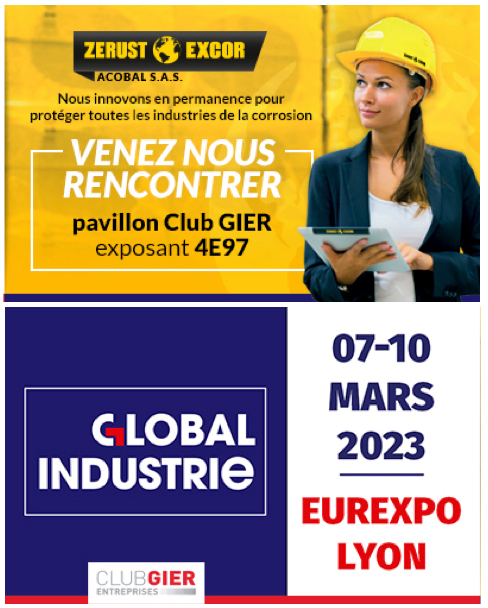1. Would you briefly introduce ZERUST®/EXCOR®?
In 1980, Northern Technologies International Corporation (NASDAQ: NTIC) filed a patent on an invention that would transform the way modern manufacturing companies protect their bare metal products as they are shipped all over the world. For NTIC had just discovered how to extrude chemical compounds that are scientifically classified as either volatile corrosion inhibitors or vapor phase corrosion inhibitors (“VCI’s”) into conventional polyethylene, thereby creating plastic packaging that actively protects any metals packed in it against rust and corrosion. Over the past four decades, the ZERUST®/EXCOR® VCI packaging brands have proven their value, over and over, to virtually every major metal products manufacturer around the world.
Forty years ago, the automotive industry still considered shipments with “zero rust” as an aspirational quality goal, but today that’s precisely what PPAP documents routinely specify and our customers achieve. Since the Bronze Age, thousands of years ago, people had relied on coating metal surfaces with viscous greases and oils, in order to prevent them from rusting and corroding. Today, however, it’s become rare to find expensive, messy, and hazardous “dipping lines” that cover products in oily rust preventative (“RP”) coatings still in use inside manufacturing plants to. It’s become equally rare to find the expensive, messy, and hazardous washing lines that were used to wash RP coatings off when parts arrived. ZERUST®/EXCOR® VCI packaging made it possible to ship metal parts clean, dry and corrosion-free.
2. Would you talk about the ZERUST®/EXCOR® groups global R&D infrastructure?
Innovation requires seeing things in novel and different ways. Therefore, we are continuously recruiting exceptional technical thought leaders to join our global R&D team.
For example, in 1994, our German joint venture company, EXCOR Korrosionsschutz Technologien und Produkte GmbH, established our first international R&D facility in Dresden, Germany under the direction of Prof. Georg Reinhard, the former head of corrosion research for East Germany. Similarly, in 2000, we established a third R&D center in Beachwood, Ohio under the direction of Prof. Efim Y. Lyublinski, the former head of corrosion research for the Soviet Union. By the beginning of 2020, the ZERUST®/EXCOR® groups technology development and applications engineering efforts had expanded even further to include Shanghai, China, Chennai, India and Sao Paulo, Brazil.
3. How did ZERUST®/EXCOR® enter the market?
After inventing VCI film, we originally introduced the technology to prospective users in the United States. Our very first customer was Caterpillar, followed by Cummins, Ford and GM. However, getting anyone to use our packaging was far from easy. At the time, NTIC was a tiny start-up based in a northern suburb of St. Paul, Minnesota. No one had ever heard of us and, obviously, no one had ever heard of VCI plastic packaging before. Furthermore, from the customer’s perspective, we were selling something akin to the “Emperor’s new clothes” from the Hans Christian Andersen fairy tale.
Heavy greases and oils had, literally, been the standard method for protecting metal from rust and corrosion for millennia. Yet here we were, trying to convince some very conservative engineers that our translucent plastic packaging film did, in fact, contain a chemical additive that was emitting a harmless gas that they couldn’t see or smell and that when they wrapped metal parts in it – nothing would happen (in other words, nothing rusted). It took two (2) years to prove the efficacy of the product with repeated field trials before getting our first order. Today, ZERUST®/EXCOR® products are sold in over 65 countries through our network of joint venture companies.
4. How do you provide global, on-site, technical service?
Metal products must reach their destination not only just-in-time but must also conform to the specified quality criteria – including “no rust” requirements. Any failure to deliver according to the agreed upon schedule and/or quality can create a parts shortage that, subsequently, may cause entire production lines to shut down, which often cost the component supplier responsible significant financial penalties. Consequently, when rust failures arise, they need to be resolved as quickly as possible.
ZERUST®/EXCOR® products are sophisticated chemistry that have been compared to “anti-rust medication”. When a doctor is confronted with a sick patient, she’ll first perform an examination to determine all of the symptoms and run tests to confirm her diagnosis. Then she’ll confirm all the other medications the patient is currently taking as well as any allergies they may have. Only then can the doctor prescribe a specific treatment plan. Solving rust problems properly requires following essentially the same methodology. Therefore, when our technical service engineers are invited into a customer’s plant, they’ll first perform a comprehensive root cause analysis, as well as collect samples of all the other chemistries currently used to test both their condition and compatibility before recommending specific corrective actions and solutions.
Our global ZERUST®/EXCOR® technical service engineers are located in virtually every country in which we do business and, on average, have more than a decade of training and hands-on experience, with about one-third also having advanced technical degrees. In turn, their efforts are supported by 12 regional technical service labs, where the ones in the USA, German and China also have fully equipped analytical labs to help address very complex cases.
